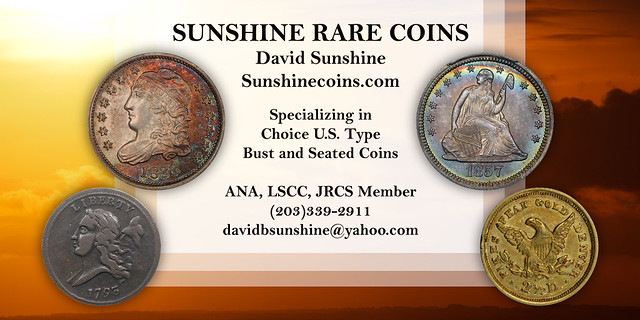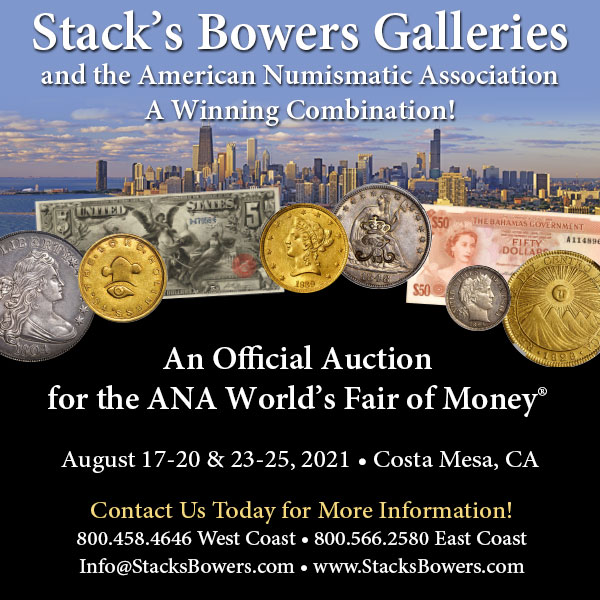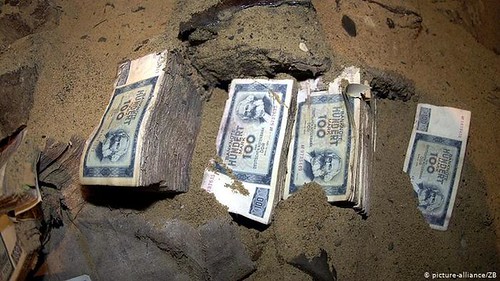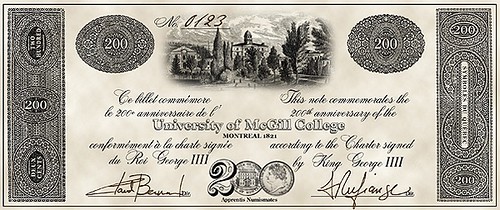
Visit our NBS Sponsors


About UsThe Numismatic Bibliomania Society is a non-profit association devoted to the study and enjoyment of numismatic literature. For more information please see our web site at coinbooks.org SubscriptionsThose wishing to become new E-Sylum subscribers (or wishing to Unsubscribe) can go to the following web page link MembershipThere is a membership application available on the web site Membership Application To join, print the application and return it with your check to the address printed on the application. Print/Digital membership is $40 to addresses in the U.S., and $60 elsewhere. A digital-only membership is available for $25. For those without web access, write to: Charles Heck, Treasurer AsylumFor Asylum mailing address changes and other membership questions, contact Chuck at this email address: treasurer@coinbooks.org SubmissionsTo submit items for publication in The E-Sylum, write to the Editor at this address: whomren@gmail.com BUY THE BOOK BEFORE THE COINSale CalendarWatch here for updates! |
- WAYNE'S WORDS: THE E-SYLUM JULY 11, 2021
- NEW BOOK: AFRICA'S LAST COLONIAL CURRENCY
- RAYMOND H. "ROCKY" ROCKHOLT (1930-2021)
- THE JOSEPH FRANCIS CONGRESSIONAL GOLD MEDAL
- RESEARCHING THE COIN COLLECTOR
- BERT KOPER'S ROLE IN CANADIAN NUMISMATICS
- MORE ON COUROC COIN PRODUCTS
- NOTES FROM E-SYLUM READERS: JULY 11, 2021
- OXFORD NUMISMATIC SOCIETY FOOTBALL COINS
- GENUINE COIN BOOK REPRINTS
- NUMISMATICS AND THE FORTSAS LIBRARY SALE
- READING AUCTION CATALOGUE LISTINGS
- VOCABULARY TERM: EXERGUE
- CAPT. ANDREW CHRISTIAN ZABRISKIE (1853-1916)
- THE 1715 FLEET SOCIETY
- ANS LYCEUM PHOTOGRAPHY WORKSHOP
- STACK'S BOWERS OFFERS LOCH NESS COLLECTION
- NUMISMATIC NUGGETS: JULY 11, 2021
- ALMOST EMPERORS: CAESARS WHO DIDN'T MAKE IT
- COINS OF THE PARISII
- THE COINAGE OF KING STEPHEN
- DISCOVERING THE 1888/7 INDIAN HEAD CENT
- 1861-O DOUBLE EAGLE
- OPERATION GET COIN MOVING AGAIN
- P. SEAVER: AN ABOLITIONIST'S COUNTERSTAMP
- THE KING OF ELONGATED COINS
- PARTRICK COLLECTION INDIAN PEACE MEDALS
- EAST CARIBBEAN STATES $100 BANKNOTES
- THE END OF THE EAST GERMAN MARK
- BRISTOL POUND TO BE WITHDRAWN
- 2021 MCGILL COLLEGE NOVELTY NOTE
- AUSTRALIAN 'KELLY BUCKS' SCRIP
- LOOSE CHANGE: JULY 11, 2021
- DESIGNING A BITCOIN BANKNOTE
Click here to read the thin version on the web
Click here to subscribe
Click here to access the complete archive
To comment or submit articles, reply to whomren@gmail.com
Content presented in The E-Sylum is not necessarily researched or independently fact-checked, and views expressed do not necessarily represent those of the Numismatic Bibliomania Society.
WAYNE'S WORDS: THE E-SYLUM JULY 11, 2021
 New subscribers this week include:
Edgardo Martinez Cabral.
Welcome aboard! We now have 6,683 subscribers.
New subscribers this week include:
Edgardo Martinez Cabral.
Welcome aboard! We now have 6,683 subscribers.
Thank you for reading The E-Sylum. If you enjoy it, please send me the email addresses of friends you think may enjoy it as well and I'll send them a subscription. Contact me at whomren@gmail.com anytime regarding your subscription, or questions, comments or suggestions about our content.
This week we open with one new book, an obituary, an update from the Newman Numismatic Portal, Notes From E-Sylum Readers, and more.
Other topics this week include The Coin Collector, Canadian dealer Bert Koper, the Fortsas Library sale, reading auction catalog listings, the 1715 Fleet, coin photography, rare coins of Scotland, coins of the Parisii and King Stephen, an abolitionist's counterstamp, the Bristol Pound and bitcoin banknotes.
To learn more about Africa's Last Colonial Currency, the Joseph Francis Congressional Gold Medal, dealer K. O. Cunningham, Canadian Money Talks, Couroc coin products, unfolding coins, Medals Struck in Honor of Abraham Lincoln, the 1861-O Double Eagle, Operation Get Coin Moving Again, and the King of Elongated Coins, read on. Have a great week, everyone!
Wayne Homren
Editor, The E-Sylum
NEW BOOK: AFRICA'S LAST COLONIAL CURRENCY
This blog article from the London School of Economics reviews a new translation of a 2018 book in French on the CFA Franc, "Africa's Last Colonial Currency". CFA stands for Communauté financière d'Afrique (Financial Community of Africa). -Editor
 Africa's Last Colonial Currency: The CFA Franc Story. Fanny Pigeaud and Ndongo Samba Sylla (translated by Thomas Fazi). Pluto Press. 2020.
Africa's Last Colonial Currency: The CFA Franc Story. Fanny Pigeaud and Ndongo Samba Sylla (translated by Thomas Fazi). Pluto Press. 2020.
The central topic of Africa's Last Colonial Currency is how France exerts control over several African countries through the CFA system, ‘the oldest monetary union in the world'. With detailed discussions of the monetary mechanisms, Fanny Pigeaud and Ndongo Samba Sylla overwhelmingly demonstrate how this system, established in 1945, preserves a hierarchy wherein the benefits to France are ‘underestimated' and the benefits to African countries are ‘exaggerated'.
Much about monetary policy can be obscure, Pigeaud and Samba Sylla readily admit. Besides this, some of the central agencies have little motivation to simplify the matter for public debate. Indeed, the technical elements of monetary policy can be used to short-circuit discussions about the desirability of the CFA system. Still, the control of currencies can have enormous political-economic consequences because, depending on how this control is structured and exercised, it can be a cause of global inequality. This is certainly the case for the 162 million people living in the West African Economic and Monetary Union (comprising of Benin, Burkina Faso, Ivory Coast, Guinea-Bissau, Mali, Niger, Senegal and Togo), the Central African Economic and Monetary Community (comprising of Cameroon, Gabon, Chad, Equatorial Guinea, the Central African Republic and the Republic of the Congo) and the Comoros. These fifteen states comprise the franc zone, and they have France mediating their monetary policy.
RAYMOND H. "ROCKY" ROCKHOLT (1930-2021)
Pete Smith submitted these recollections of Rocky Rockholt. Thanks. -Editor
I learned of the death of Rocky Rockholt in the current issue of TEC News. Below is his listing from American Numismatic Biographies.
Rockholt, R(aymond) H(owell) "Rocky" Author
(b. 7/25/1930 d. 4/26/2021)
THE JOSEPH FRANCIS CONGRESSIONAL GOLD MEDAL
Newman Numismatic Portal intern Garrett Ziss provided the following article based on recently added digital content relating to a great U.S. Mint medal. Thanks! -Editor
Even though he had been feted by many other countries, it wasn't until 1890 that the Congressional Gold Medal was bestowed upon 89-year-old Joseph Francis by President Benjamin Harrison. This American inventor dedicated his career to producing life-saving water craft, which was made possible by his invention of a machine that mass produced corrugated metal. His vessels were employed at coastal rescue stations around the world and saved thousands of lives.
RESEARCHING THE COIN COLLECTOR
Rusty Goe submitted this update on his research involving mail bid sales in The Coin Collector. Thanks! -Editor
After a little more than three weeks into my research project regarding K. O. Cunningham mail bid sales in The Coin Collector, I finally hit pay dirt. Not a big bonanza, mind you, but a sufficiently sizable vein.
With the helpful cooperation of Hang Nguyen, Ph.D., reference librarian at the State Historical Society of Iowa, I now have PDF copies of three of the five K. O. Cunningham sales for which I have searched.
Hang Nguyen followed the leads I sent and browsed through issues of The Coin Collector on microfilm at the Iowa library. Hang scanned the three K. O. Cunningham mail-bid advertisements found, including the cover pages for each issue, and emailed them to me.
BERT KOPER'S ROLE IN CANADIAN NUMISMATICS
On Wednesday, July 7 Howard Engel of Richard Stockley Books made an online presentation for the South Wellington Coin Society. Here's a synopsis. I was unable to attend, but David Gladfelter provided some commentary. Thanks. -Editor
Bert Koper (1899-1963), a Dutch immigrant to Winnipeg, almost single-handedly kept the torch of organized numismatics burning in Canada through the dark years of the Depression and World War II. His Park Coin Shop, Canadian Numismatic Art Society, and subsequent Canadian Coin Club Society (fl. 1935-1951) filled the gap between the Antiquarian and Numismatic Society of Montreal's demise in 1934 and the Canadian Numismatic Association's birth in Ottawa in 1950. Numismatic literature aficionados collect his publications; his enthusiasm inspires collectors today. He nearly succeeded in organizing a nation-wide numismatics association… Koper burned out, but he passed the Canadian numismatic torch to the R/CNA. He is Engel's local example of an unsung numismatist whose contribution to the hobby is worthy of research. You may find such numismatists in your own backyard…
MORE ON COUROC COIN PRODUCTS
Steve Shupe of Los Gatos, CA writes:
"Here is a little information on the Couroc company. I was given as a gift a tray made by this company with the Monterey Cyprus tree in the early nineties by my sister. Still a useful serving tray that we use when throwing a party.
"It is similar to Bakelite as a material. A screenshot of ETSY shows that they made many different designs and pieces and now sell used for about $50 with and without designs with coins."
NOTES FROM E-SYLUM READERS: JULY 11, 2021
Philadelphia Mint Restriking Research ProjectDear Fellow Numismatists,
A current research project is to understand the restriking and distribution of circulation coins and pattern pieces by the Philadelphia Mint from about 1834 to 1897. Substantial progress has been made in identifying persons responsible and many of the coins involved; however, much remains to be discovered.
I would appreciate hearing from anyone with new or unpublished information, including private family papers, diaries and notebooks, that relate to this subject. While final analysis and publication of results remains in the future, the results are expected to wipe away many decades of speculation and innuendo.
Interested collectors may contact me at Seneca Mill Press LLC, P.O. Box 1423, Great Falls, VA 22066-1423.
Thank you!
Roger W. Burdette
Other topics this week include the National Association of Token Collectors, coin dealers as entertainers, and the new Liberty Dollar. -Editor
OXFORD NUMISMATIC SOCIETY FOOTBALL COINS
" To celebrate England's success in getting to the final of Euros 2020 Oxford Numismatic Society has published a football post on its website."
To celebrate the England football team getting to the Euro Final here are a few football coins.
The middle one is an interesting design by Neil Wolfson, a sports journalist who chose an image which he felt would encapsulate the sport. it is one of the rarer commemorative 50 pence coins. I have previously suggested the Royal Mint brings out a penalty knock out coin. Let us hope there an England Winners 50 pence coin
Congratulations on the win! -Editor
To read the complete article, see:
Saturday, 10 July 2021
(http://oxfordnumismaticsociety.blogspot.com/)
GENUINE COIN BOOK REPRINTS
Dave Lange passed along this wooden nickel with a connection to numismatic literature. Thanks! -Editor
I'm not a collector of wooden nickels, but I had to buy this one as a research project.
NUMISMATICS AND THE FORTSAS LIBRARY SALE
Gary Oddie recently published an article for the British Numismatic Society blog relating to books and coins. Well worth reading - there is something here for both numismatists and bibliophiles, -Editor
 Few library sales catalogues have generated as much interest at the time or subsequently as that printed for the sale of the library of Mr le Comte J.-N.-A. de Fortsas on the 10 August 1840. The auction report appeared in a local newspaper, describing the strong bidding, along with some of the prices realised and names of the buyers. Original copies of the catalogue were selling at a significant premium shortly after the date of the sale and it has been reprinted and translated several times. Chapters of books have also been written describing the build-up to the sale, the day of the sale and its aftermath. The event even makes an appearance on a Wikipedia page. An original copy of the catalogue was auctioned recently by Sotheby's and made £3,250 against an estimate of £2,000-£3,000 and was subsequently seen offered for sale at £8,500.
Few library sales catalogues have generated as much interest at the time or subsequently as that printed for the sale of the library of Mr le Comte J.-N.-A. de Fortsas on the 10 August 1840. The auction report appeared in a local newspaper, describing the strong bidding, along with some of the prices realised and names of the buyers. Original copies of the catalogue were selling at a significant premium shortly after the date of the sale and it has been reprinted and translated several times. Chapters of books have also been written describing the build-up to the sale, the day of the sale and its aftermath. The event even makes an appearance on a Wikipedia page. An original copy of the catalogue was auctioned recently by Sotheby's and made £3,250 against an estimate of £2,000-£3,000 and was subsequently seen offered for sale at £8,500.
The following sections will present details of the sale and then three numismatic and bibliophilic connections that came to light whilst looking into this auction.
READING AUCTION CATALOGUE LISTINGS
Charles Morgan and Chris Bulfinch recently published an article on CoinWeek about an essential skill for collectors - reading auction catalog listings. Here's an excerpt - see the complete article online. -Editor
As a collector advances in the hobby, they might find themself nose deep in one of the many beautiful catalogs produced by the hobby's premier auction houses. These catalogs offer a unique blend of numismatic research, commentary, jargon, and marketing hype – all of which work to represent the interests of the consignor and help the catalog publisher instill excitement so that a given coin sells for the most money possible.
VOCABULARY TERM: EXERGUE
Here's another entry from Dick Johnson's Encyclopedia of Coin and Medal Terminology. -Editor
Exergue. The segment of a coin or medal design beneath a base line, usually containing lettering. While exergue means the area beneath the base line, by extension it also means the lettering within this area. Designing any scene or illustration with a ground line and placing this in a circular shape gives rise to the area so described. From almost the beginning of the Renaissance medal, the exergue was being used. It was a logical place to put additional information: signatures, dates, mottos, inscriptions and such, some lines in smaller letters than others for variety. Only in rare instances was any ornamentation placed there, so important was it for lettering. An exergue can only exist on a circular or rounded bottom; if the area has square corners the lower portion is a plinth. See panel.
THE BOOK BAZARRE
CAPT. ANDREW CHRISTIAN ZABRISKIE (1853-1916)
Here's another entry from the online draft of John Lupia's book of numismatic biographies. Thanks! This is an excerpt with the full article and bibliography available online. This week's subject is author and collector Capt. Andrew Zabriskie. I added an image of Zabriskie's Lincoln medal monograph. -Editor
Zabriskie, Capt. Andrew Christian (1853-1916), 52 Beaver Street, New York.
He was born in New York City, New York on May 30, 1853, son of Christian A. (1829-) of New Jersey and Sarah Jane (Titus) Zabriskie (1833-), who were married in 1849 at New York City, New York, New York. He was born into one of the largest real estate owning families in that city. He studied at the School of Mines and Columbia College. After graduating from Columbia University, Zabriskie helped manage the family's real estate business.
In 1872 he is cited by his initials A. C. Z. in Mason's Coin and Stamp Collector's Magazine VI, No. 1, January (1872) : 20 ; and by the initials A. Z., in Mason's Numismatic Herald Vol. I, No. 1, June (1879) : 6a. Zabriskie was a lifelong collector. During his career he amassed a large collection, the most significant of which were Lincoln medals and Polish (i.e., coins and medals of Poland, not polished) coins and medals. His most lasting achievement as a collector is in the field of Political tokens and medals; most specifically his focus on the sixteenth president.
THE 1715 FLEET SOCIETY
Ben Costello submitted this information about the 1715 Fleet Society, dedicated to researching the history of the lost Spanish fleet and its treasure. Thanks! -Editor
The 1715 Fleet Society has a rather comprehensive website at 1715fleetsociety.com Please visit it sometime. We were founded in 2008 for the purpose of planning a commemoration of the 300th Anniversary of the loss of the Fleet. It actually did take 7 years to pull it off. We had a week long program which included receptions in 3 Florida communities that were long associated with wreck site remains ...Sebastian, Vero Beach and Ft. Pierce. The 11 ships that were destroyed in the great hurricane of July 30-31, 1715 were scattered over a 35 mile stretch of beach from Sebastian to Ft. Pierce, on the east coast. So, logically, that is where the focus of our commemoration centered. We also had a major exhibit in January, 2015, 7 months before the actual commemoration to kick off the year. This exhibit was in Orlando at the FUN Show. The exhibit was in conjunction with a partner ship we formed with the State of Florida. The State arranged to send their collection of Fleet coins and artifacts to Orlando for the exhibit.
ANS LYCEUM PHOTOGRAPHY WORKSHOP
The American Numismatic Society is sponsoring a workshop on numismatic photography. Here's the announcement. -Editor
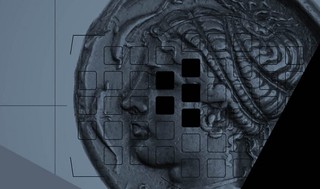 Registration for the third course of the ANS Lyceum is now open. Fill out the form below and submit tuition payment on the following page to register for the July 14 to August 4 ANS Lyceum "Photography Workshop". Sessions will be held on Wednesdays from 12:30 pm ET to 2 pm and will be taught by ANS Senior Photographer Alan Roche. Tuition for members of the American Numismatic Society is $100.00 USD. Tuition for this four-week workshop is $250.00 USD for non-members. The next page will confirm your registration and direct you to a payment page. Join the ANS today at
numismatics.org/membership/ to receive the membership rate.
Registration for the third course of the ANS Lyceum is now open. Fill out the form below and submit tuition payment on the following page to register for the July 14 to August 4 ANS Lyceum "Photography Workshop". Sessions will be held on Wednesdays from 12:30 pm ET to 2 pm and will be taught by ANS Senior Photographer Alan Roche. Tuition for members of the American Numismatic Society is $100.00 USD. Tuition for this four-week workshop is $250.00 USD for non-members. The next page will confirm your registration and direct you to a payment page. Join the ANS today at
numismatics.org/membership/ to receive the membership rate.
STACK'S BOWERS OFFERS LOCH NESS COLLECTION
Stack's Bowers is offering a major collection of Scottish Coins. Here's the press release. -Editor
SCOTLAND. 20 Pound Piece, 1576. Second Coinage, Before Accession to English Throne. Edinburgh Mint. James VI (I of England). NGC VF-20.
Stack's Bowers Galleries is pleased to feature the Loch Ness Collection of Scottish Coins in their Official World Coin Auction for the ANA World's Fair of Money. It is a landmark cabinet that will stand as a reference of quality and rarity for generations to come. It provides a magnificent showcase across six centuries of coinage, spanning from the primitive sterling issues under David I in the 12th century to the final emissions of the Edinburgh Mint under Anne in the beginning of the 18th. This historic tour touches upon some of the most pivotal periods in Scotland and the British Isles, illustrating themes of the Middle Ages, the Renaissance, and the Enlightenment in dazzling gold and silver. Even the most recent of these coinages predate the American and French Revolutions by nearly a century.
NUMISMATIC NUGGETS: JULY 11, 2021
Here's a selection of interesting or unusual items I came across in the marketplace this week. Tell us what you think of some of these. -Editor
(lot of 2) Patinated bronze relief plaques, including: (1) French bronze patine medal, Emperor Napoleon Bonaparte and Marie-Louise in profile, signed in cast Andrieu fecit. (Jean-Bertrand Andrieu, French, 1761-1822), after a drawing by Dominique Vivant Denon (French, 1747-1825), on easel stand, medal: approx 4 7/8"diam, (1) framed bronze dore et patine medal, Claudius Caesar in profile, medal: approx 3.5"h, 2.75"w, overall: approx 7.5"h, 6"w; 1lbs total **Provenance: From a prominent Dallas, Texas estate** Start Price: $150.00
Unusual and nicely done. Great decoration for a numismatic office or library. -Editor
To read the complete lot description, see:
(2) BRONZE RELIEF PLAQUES NAPOLEON & CLAUDIUS
(https://www.liveauctioneers.com/item/107267915_2-bronze-relief-plaques-napoleon-and-claudius)
Other topics this week include Trump and Kennedy tokens and medals. -Editor
ALMOST EMPERORS: CAESARS WHO DIDN'T MAKE IT
A CoinWeek article by Steve Benner discusses coinage of three "almost Emperors" who came close, but didn't ultimately ascend to be Emperor of Rome. This is an excerpt - see the complete article online. -Editor
This article deals with three men that, while seemingly destined to become the emperor of ancient Rome–indeed, they held the title of Caesar, or second-in-command–ultimately failed, for one reason or another, to ascend the throne.
COINS OF THE PARISII
The Writer's Almanac for Thursday, July 8, 2021 mentioned the coins of the Parisii, the Celtic tribe that founded Paris. I've added some coin images. -Editor
It was on this day in 49 B.C. that the Parisii, a tribe of Celtic fishermen, first set foot in what would become the magnificent city of Paris. The Parisii settled on the banks of the Seine and formed a town that became known as Lutetia, which meant Midwater-Dwelling.
They mostly lived in thatched wooden huts, but they were smart, and fierce, and had their own coinage with their name on it, and began successfully trading with other European settlements. They built bridges, a fort, and minted coins. We mostly know about them from Julius Caesar's Commentaries on the Gallic Wars (52 B.C.), which detailed the sacking and pillaging of Lutetia by the Roman army in 52 B.C. Rather than give up their town, the Parisii burned it to the ground. The Romans won, though, and brought with them such modern conveniences as a theater, baths, a forum, and even a temple.
Remnants of the Parisii and the early town of Lutetia were first discovered in the 19th century when the medieval streets were torn up to accommodate Baron Haussmann's redesign of the city of Paris.
THE COINAGE OF KING STEPHEN
A new online exhibit at the Hunterian museum in Glasgow highlights the coinage of King Stephen's reign. -Editor
Medieval English kings fiercely preserved their monopoly of the coinage. Coins were crucial to the economy, but also important symbols of royal power. If a monarch couldn't control the name and image that appeared on coins, what would that say about their authority, and those who usurped royal rights?
Control of the coinage famously broke down during the ‘Anarchy': a civil war between King Stephen (r. 1135-1154) and the Empress Matilda. Alongside Stephen's issues, Matilda also struck coins, as did individual barons, who may have been taking advantage of the absence of royal authority to build their own autonomous power blocs. Here too we find the first King of Scotland to mint coins, David I.
DISCOVERING THE 1888/7 INDIAN HEAD CENT
Dave Bowers has a nice Stack's Bowers blog article about Jim Ruddy's discovery of the 1888/7 Indian Head Cent. Neat story. -Editor
In 1969 Jim Ruddy purchased a small cache of Indian Head cents found in an attic of a mansion in Virginia. These had never been examined by a numismatist. Jim had been interested in die varieties for a long time, and over a span of years had discovered several remarkable items, one of which was a new die for the 1786 Date Under Plow Beam New Jersey copper, a classic in that series.
Studying his newly acquired group of Indian Head cents by examining them under low-power magnification, Jim noticed that one bearing the date 1888 seemed to have traces of a 7 under the last digit. Could this be? No one had ever heard of such a thing!
1861-O DOUBLE EAGLE
This Heritage press release discusses an interesting Civil War gold coin. -Editor
Civil War $20 Gold Piece Minted by New Orleans Under Siege
Most people may think of the US Mint as a fairly non-political institution, simply making coins for all people in America to use equally. However, mint buildings have been political pawns at a few points in history, especially during the Civil War. The 1861-O $20 gold pieces struck in New Orleans bear the dubious distinction of having been minted partially by Union forces, partly by the State of Louisiana, and partly by the Confederacy! One such historic and fascinating coin will be part of the upcoming July US Coin Auction #1332.
OPERATION GET COIN MOVING AGAIN
This article from Watertown, NY shows the continuing effects of the pandemic on coin circulation. -Editor
Local banks are seeing the effects of a coin shortage and are asking you to cash in those coins you have stored in a jar at home.
We're just right back at that full circle piece where we just want to get coin moving again, have our clients bring those in and just get it back into circulation,
said Janessa Sparacino, assistant vice president banking officer, Watertown Savings Bank.
When the COVID pandemic hit, fewer people were going out. And fewer people were using bills and coins out of fear of spreading the virus.
P. SEAVER: AN ABOLITIONIST'S COUNTERSTAMP
Bill Groom submitted an article about an abolitionist's counterstamp. This is an excerpt - the full version appears in the July 2021 issue of Talkin' Tokens from the National Token Collectors Association (NTCA). -Editor
by Bill Groom
Few chapters in American history are as compelling and heart-wrenching as the one on slavery. Upon researching the below-pictured counterstamp, I was deeply reminded of that. An unknown maverick when acquired from a Dave Bowers box, it was unlisted by Brunk or Rulau. Since this P. SEAVER / Oxford, Mass. stamping was an uncommon surname and supplied a town/state name, I found it to be an irresistible purchase.
THE BOOK BAZARRE
THE KING OF ELONGATED COINS
Len Augsburger passed along this article about the upcoming sale of one of the world's earliest souvenir elongated cents, made at the 1904 World's Fair. Thanks. -Editor
Have you ever gone to the zoo or a museum and received a stretched coin as a souvenir? Well, the The King of Elongated Coins
from the 1904 World's Fair is up for auction and the lot including two other coins could be worth up to $4,000.
PARTRICK COLLECTION INDIAN PEACE MEDALS
Greg Reynolds published a Greysheet blog article about the George Washington Indian Peace Medals sold in the recent Heritage Partrick sale. The article includes an interview with E-Sylum contributor Alan Weinberg. Here's an excerpt - see the complete article online for more. -Editor
Two American Indian Peace Medals from the 18th century were highlights of the special Partrick Platinum Night auction session on April 22. This was part of a large auction extravaganza conducted by Heritage at this firm's headquarters near the Dallas Fort Worth Airport.
The most noteworthy result in this Partrick session was the $630,000 paid for a 1793 Indian Peace Medal that depicts George Washington, the first president of the United States. He was earlier the commander-in-chief of American revolutionary forces during the battle for independence from Great Britain.
EAST CARIBBEAN STATES $100 BANKNOTES
The World Banknote Auctions Sale 12 ends July 22, 2021, and lots are open for bidding on the firm's website. Founder Dennis Hengeveld published an article about the East Caribbean States $100 Banknotes. Here's an excerpt. -Editor
East Caribbean States: An Introduction
Starting in the early 17th century, the British claimed several islands in the Caribbean, competing directly with Dutch, French and Spanish interests in the region. Known as the British West Indies, early claims included St. Kitts (the first British settlement in the region, in 1624 by Thomas Warner), Antigua and Montserrat (both in 1632). With possessions in both the leeward and windward islands of the Caribbean, British control stretched over a large area, and the region was collectively known as the British West Indies. The economy of the region primarily focused on sugarcane, which flourished in the tropical climates. Initially the islands were divided between the leeward and windward islands, but in 1962 most were combined into the short-lived West Indies Federation. When this was dissolved some countries became independent, while others became colonies controlled directly by London, later gaining independence. It was these colonies that would introduce the East Caribbean Dollar, in 1965, and most continue to do so to this day, even after independence, although some changes among the members have been made over the years.
THE END OF THE EAST GERMAN MARK
Kavan Ratnatunga passed along this article about the demise of the East German mark. Thanks. -Editor
Kavan writes:
"I can still remember getting some East German Mark coins in exchange 1:1 for West German Marks when I visited as a tourist in 1985. The Best Museums were in East Berlin and had to go through checkpoint Charlie. "
This week marks the 28th anniversary of the monetary union between East and West Germany. What promised to be a healing cure-all for both sides killed the East German mark and is still a work in progress today.
BRISTOL POUND TO BE WITHDRAWN
It looks like it's the end of the line for the Bristol Pound alternative currency. -Editor
A local currency launched in Bristol nearly a decade ago is to be withdrawn from circulation.
At its peak there were over £1m Bristol pounds in circulation and there is still about £40,000 "out there in people's pockets", the company said.
But the growth of cashless payments and cryptocurrencies made the currency less competitive and it is folding.
2021 MCGILL COLLEGE NOVELTY NOTE
Canadian Coin News published an article about the latest issue in the Apprentis Numismates ‘Symboles du Québec' novelty note series. Here's an excerpt - see the complete article online. -Editor
The Apprentis Numismates, a French-Canadian numismatic organization founded in 2001, has unveiled the fifth issue of its Symboles du Québec
commemorative banknote series.
The group's officials, including founder Claude Bernard and long-time member François Rufiange, who joined in 2005, commemorated Québec's oldest university, McGill, on the new novelty issue. Only 200 notes, including five uncut press sheets with three notes each, were available to collectors beginning on May 1.
AUSTRALIAN 'KELLY BUCKS' SCRIP
Rich Giedroyc published an article in Numismatic News about an Australian lawmaker's satirical banknotes. Here's an excerpt - see the complete article online. -Editor
In 2011 it was suggested the United States issue a very high face value platinum coin as a way to bypass U.S. Congress needing to raise the nation's borrowing limit. The Federal Reserve and the Treasury rejected the idea of these trillion-dollar coins two years later. Congresswoman Rashida Tlaib resurrected the idea in 2020 as a way to fund monthly $2,000 stimulus payments until the end of the coronavirus pandemic. We've all seen where that idea went.
LOOSE CHANGE: JULY 11, 2021
Here are some additional items in the media this week that may be of interest. -Editor
Jay Turner published an article on PCGS.com about the Nevada State Museum at the site of the Carson City Mint -Editor
To read the complete article, see:
Numismatic Destinations – Nevada State Museum: The Former Carson City Mint
(https://www.pcgs.com/news/numismatic-destinations-nevada-state-museum-former-carson-city-mint)
Other topics this week include the Silver Queen of Virginia City, Coins of the Middle Ages, and Kentucky banknotes. -Editor
DESIGNING A BITCOIN BANKNOTE
Recently we discussed the new firm Noteworthy which intends to create "physical banknotes that represent various denominations of Bitcoin and other digital currencies, marrying the traditional and familiar elements of paper currency with the modernity of digital assets without compromising reliability, security, or trust."
Noteworthy Chief Design Officer Manuela Pfrunder wrote an article on the company's website about the task of designing a bitcoin banknote. -Editor
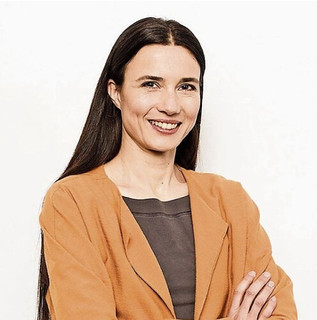 When the team at Noteworthy called to ask if I'd be interested in designing a bitcoin banknote, it was an easy
When the team at Noteworthy called to ask if I'd be interested in designing a bitcoin banknote, it was an easy Yes.
Their mission and vision to create a top-of-the-line physical representation of a digital currency is innovative, inspiring, and no easy feat. As Noteworthy's Chief Design Officer, I had the challenging task of developing a product that perfectly marries past and future, utility, and style.
Because of its complexity, Noteworthy had to ensure that each feature on the physical note was designed with intention and purpose. Designing a normal banknote is incredibly complex and there are many elements that need to be considered. But Noteworthy isn't a normal banknote, it's one that combines the originality of paper money with the security benefits of digital assets and blockchain technology, presenting the team with a whole set of new challenges. We had to scrutinize all elements of their functionality; which security features are important to users, what it should feel like, if we wanted to include a portrait, which color schemes would resonate with the public, and so much more.











































